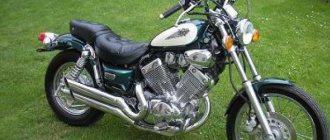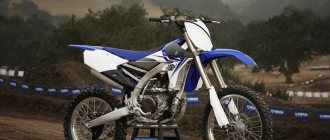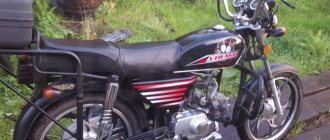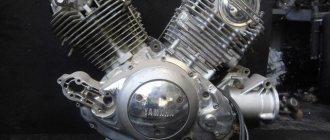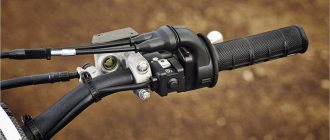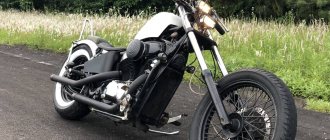Japanese motorcyclesYamaha motorcycles
Japanese companies, interested in the vast American market for motorcycle products, rushed to conquer it.
And since the American buyer is spoiled by their own products, Japanese companies had to adapt to these realities.
The pioneer in the creation of American-style cruiser road motorcycles was Yamaha. It was she who released the first cruisers with a V-twin engine.
The first models were designated XV-1000TR1, with a liter engine 750 cc model XV-750 Special, and they were released in 1980. A little later, these models were given the name Virago.
To prevent Japanese products from completely squeezing their own American motorcycles out of the market, the US government increased duties on the import of bikes with engines over 700 cc. cm.
But this did not stop Yamaha, the company simply began producing motorcycles with a smaller displacement , so the Virago line only expanded.
Specifications
Technical characteristics of Yamaha XV750 Virago:
| Model | Yamaha XV750 Virago |
| Motorcycle type | cruiser |
| Year of issue | 1981-1998 |
| Frame | steel backbone (engine – load-bearing part) |
| engine's type | 2-cylinder, 4-stroke, V-shaped |
| Working volume | 748 cm³ |
| Bore/Stroke | 83.0 x 69.2 mm |
| Compression ratio | 8.7:1 |
| Cooling | air |
| Number of valves per cylinder | SOHC, 2 valves per cylinder |
| Fuel supply system | carburetor, 2x Mikuni BST40 |
| Ignition type | transistor TCI |
| Maximum power | 60.0 hp (44.0 kW) at 7000 rpm - XV750 (1981-1985) 55.0 hp (41.0 kW) at 7000 rpm – XV750 (1986-1998) |
| Maximum torque | 64.7 Nm (6.6 kg-m) at 6000 rpm - XV750 (1981-1985) 59.0 Nm (6.0 kg-m) at 6000 rpm - XV750 (1986-1998) |
| Clutch | Multi-disc in oil bath, cable drive |
| Transmission | 5-speed |
| type of drive | cardan |
| Front tire size | 100/90-19 (57H) |
| Rear tire size | 140/90-15M/C (70H) |
| Front brakes | 2 discs, 282 mm, 2-piston calipers – XV750 (1981-1993) 2 discs, 298 mm, 2-piston calipers – XV750 (1994-1998) |
| Rear brakes | drum |
| Front suspension | telescopic fork (non-adjustable), travel – 150 mm |
| Rear suspension | pendulum with monoshock absorber, stroke – 100 mm – XV750 (1981-1983) pendulum with two shock absorbers, stroke – 97 mm – XV750 (1984-1998) |
| Motorcycle length | 2230 mm – XV750 (1981-1983) 2285 mm – XV750 (1984-1998) |
| Motorcycle width | 850 mm – XV750 (1981-1983) 840 mm – XV750 (1984-1998) |
| Motorcycle height | 1160 mm – XV750 (1981-1983) 1190 mm – XV750 (1984-1998) |
| Wheelbase | 1525 mm |
| Seat height | 715 mm |
| Minimum ground clearance (clearance) | 145 mm |
| Acceleration to 100 km/h | 5.4 sec |
| Maximum speed | 168 km/h |
| Gas tank capacity | 14.5 l (including reserve - 2.5 l) |
| Motorcycle weight (curb) | 235 kg |
Features and Specifications
The Yamaha XV750 Virago is a typical short wheelbase chopper. In his chest beats a double V-shaped revving heart, with a volume of 748 cubic meters and from 55 to 60 horsepower. It was capable of accelerating the bike to 180 km/h, which is impressive even by modern standards.
Despite the impressive engine characteristics, the Virago 750 did not have a voracious appetite and consumed a little more than 6 liters per hundred.
Everyone who has had experience driving Viraga notes her liveliness of character, which is uncharacteristic for choppers. The bike accelerates easily and corners effortlessly. At the same time, any complex maneuver does not cause discomfort to the motorcyclist, which is facilitated, first of all, by the perfect design of the front shock absorber, which literally swallows even impressive potholes. The rear shock absorbers cannot boast of such efficiency, but in general they do not violate the overall idyll of comfort and ease of control.
You can also note the seat located as low as possible. It is soft and comfortable even for a passenger, which also sets Viraga apart from the crowd of brutal cruisers.
Technical features of Virago 400
How is the 400cc Yamaha Virago motorcycle different from other choppers?
Air-cooled V-twins have one common problem - the rear cylinder often overheats. But, examining numerous reviews on the Yamaha Virago 400, there is no mention of overheating. Thanks to the large camber and the displacement of the second cylinder to the side, air circulates freely between the heads and effectively cools the engine. The power unit is stable even in extreme situations. Even bad gasoline can’t stop you from moving forward. The cardan transmission, which came to replace the chain a year after the start of production, only simplified operation. The reliability of the cardan became the calling card of the “Witch,” destroying many stereotypes. The annual replacement of fluids in the gearbox is all care and maintenance.
Design features
Legendary handling and maneuverability are achieved not only by the low location of the second gas tank. The front fork is designed with a minimum offset, which allows you to avoid creases when cornering.
From the outside it seems that all Viraga’s units are floating in the air. In fact, the parts are mounted on a tubular frame. The front suspension is reliable. A simple telescopic fork confidently holds the road and “swallows” potholes. A simple double-sided swingarm and shock absorbers make up the rear suspension.
The bike is compact in size, but reading reviews of the Yamaha Virago 400, there are owners taller than 175 cm. Many install additional footpegs or lower the gear foot for more comfortable control. The standard ground clearance is enough to overcome holes and obstacles. Viraga feels great on dirt roads and adequately “carries” a passenger if its dimensions are within reason.
The Yamaha Virago 400 model has not only the technical characteristics that ensure such popularity - it has a number of minor drawbacks. Studying the forums of fans of the Yamaha model, the Virago 400 model, I often come across reviews about the unstable operation of the electrical part. The weak point is the generator and charging relay. Therefore, the main condition for a successful trip, especially over long distances, is a high-quality battery. Some noise that characterizes the operation of an air-cooled engine becomes familiar after just a few days of use.
Another feature of the Yamaha 400 was a slightly increased oil consumption. It is due to thermal clearances that are larger than those on water-cooled engines. Adding oil should not be considered a problem. These are just design features of the motorcycle.
The light weight of the Yamaha Virago 400 - 180 kg and other technical characteristics, such as a standard convenient 5-speed gearbox in a coupe with a small wheelbase - is an ideal combination for beginners in the two-wheeled world and girls. Judging by the reviews, many endow “The Witch” with special qualities.
Another drawback is that the brakes are rather weak at high speeds and are not conducive to fast driving, because despite its small volume, the Virago has excellent acceleration dynamics. The Yamaha Virago 400 offers technical characteristics unusual for a cruiser: instant acceleration and the ability to enter an almost controlled skid.
After many years, Virago is distinguished by the best price-quality ratio on the secondary market and comfortable ergonomics.
https://youtube.com/watch?v=uRntUksw1Kg
Specifications
| Power: | 40 HP |
| Torque: | 34 Nm at 7000 rpm Nm |
| Engine type (cylinder arrangement): | 2-cylinder, V-engine, 4-stroke |
| Number of cylinders: | 2 |
| Engine capacity: | 399 cm3 |
| Cooling type: | Air |
| Transmission: | mech., 5-speed |
| Drive unit: | cardan shaft |
| Frame: | Steel |
| Weight: | 178 kg – dry. 199 kg - equipped. kg |
| Tank capacity: | 14 l. |
| Maximum speed: | 140 km/h |
| Wheelbase: | 1520 mm |
Flaws
Early users of the XV750 Virago complained of starter malfunctions. But in 1986, Yamaha engineers radically solved this problem by equipping the entire line with a new engine with a more reliable starting system.
The second drawback is the excessively short footrests, which do not always accommodate massive biker boots. As a result, when making a sharp turn, there is a risk of dragging your shoes along the asphalt.
Video
Virago XV 400
– this motorcycle is very popular among novice bikers, not least because of its affordable price.
A living device can be purchased for 100 thousand rubles, or even less if you’re lucky. Of all the 400 cc classmates, the Virago 400 is one of the most peppy bikes. Thanks to its low weight (about 150 kg) and 40 hp. it is very, very dynamic at speeds from 0 to 100 km/h. After a hundred, of course, it begins to quickly deflate, and finally refuses to accelerate when the speedometer marks 140 km/h. The heart of the XV 400 is a 2-cylinder v-shaped air-cooled engine, which is not picky about fuel quality. The author of this text, who at one time rode a Virago 1100, once personally poured 76 gasoline into the tank for lack of anything else, and nothing, the motorcycle withstood this mockery. The Virago cardan drive is reliable, as always (only the youngest Viragos - 125cc and 250cc versions - were produced with a chain drive). It is also worth mentioning that the Virago XV 400 was produced in two versions, the first of which had only one gas tank under the saddle. The Virago 400-2 has a small second gas tank instead of a false tank. This, by the way, is also true for Virago XV 535 of various years of production.
Both of the above-mentioned “witches” are built on the same base, and differ mainly only in the cylinder-piston group. If desired, the 400 cc Yamaha Virago can be converted into a 535 cc one. But the meaning of such tuning is a big question due to its tangible cost, which will never be repaid if the motorcycle is resold. Although if you manage to buy a used motor at a motor disassembly site, the final price of tuning may not be so high. In addition, if the arms grow from the right place, and their curvature does not exceed the statistical average, you can cope with replacing the motor yourself, calling your comrades for help.
The younger Yamaha Virago - 125 and 250 - are similar to each other and very different from the 400/535 and 750/1100 versions. They have their own frame and chain drive, while all other Virags have a cardan drive. Outwardly, all “Witches” are similar to each other, at least in general terms, but they all have the same style
So if you started with the youngest motorcycles in this series, and you liked them, then you should pay attention to the larger models. It's the same thing, only bigger and better
And starting to get acquainted with choppers with a Yamaha Virago 125 or 250 is a good idea if you can find them on sale. Small and light, they will be an excellent “study desk” for a beginner. Although the prices for the 400 cc version are not that much different, so perhaps it’s worth thinking about the XV 400 right away.
The older Yamaha Virago models share a different platform and, like the 400/535 versions, differ from each other mainly in the CPG.
Modifications
In general, during the entire production of the XV750 Virago, there were only 2 versions of the bike. The wheels of one were cast, and the other had spokes. But besides this, Yamaha constantly refined its brainchild, changing certain components. Power fluctuated over the years from 55 to 60 hp, the shock absorber, air filter, brake discs, tank shape, etc. were repeatedly improved. And in 1984, the engine size was radically reduced. This was due to the fact that in terms of sales, the Yamaha cruiser began to step on the heels of its competitors from Harley-Davidson. They lobbied for an increase in taxes on imported motorcycles with engines over 700cc. As a result, in order to remain in the American market, Yamaha reduced the volume from 750 to 699, thanks to which it remained in the American market for several more years.
Today, the average price for an old Yamaha XV750 Virago is $2300-3000.
Virago 400 version
Later, in 1987, the company released two more models of the Virago line - the export XV-535 and the domestic XV-400 model, which subsequently began to be sold in other countries.
It is the 400 cc “Witch” (that’s how “Virago” is translated) that will be discussed.
The XV-400 was in production until 1998, after which it was replaced by the Drag Star generation with its 400 cc model.
But the XV-400 is still in demand, and it is positioned by its nature as a motorcycle for beginners.
Despite its modest volumetric figures, the Virago 400 is fully consistent in appearance with American-style “cruisers”.
Low seating, small teardrop-shaped tank, high steering wheel and a large number of chrome elements.
Due to the slightly protruding fork forward, which is more typical of classic bikes, the Virago 400 has excellent handling and maneuverability.
Brief history of the model
Model
: Yamaha XV250 Route 66 / Virago (USA, Europe).
Factory designation
: XV250U; 3DN1.
Model
: Yamaha XV250 Route 66 / Virago (USA, Europe).
Factory designation
: XV250W; 3LU1, 3LS1, 3LW1, 3DN2.
Model
: Yamaha XV250 Route 66 / Virago (USA, Europe).
Factory designation
: XV250A; 3DN3.
Model
: Yamaha XV250 Virago (Japan, Europe).
Factory designation
: 3DM5, 3DM6, 3LS1.
Model
: Yamaha XV250 Virago (Japan, Europe).
Factory designation
: 3DM7, 3DM8, 3LS2, 3LW2, 3LU2.
Model
: Yamaha XV250 Virago (Japan, Europe).
Factory designation
: 3DM9, 3DMA, 3DMB, 3DMC, 3DN4, 3LS5, 3LS6, 3LU3, 3LW3.
Model
: Yamaha XV250 Virago (USA, Europe).
Factory designation
: XV250G; 3LW4, 3LW5, 3LS7, 3LS8, 3LS9, 3DN5, 3LU4, 3LU5.
Model
: Yamaha XV250 Virago (USA, Europe, Japan).
Factory designation
: XV250H; 3LW6, 3SLB, 3LU6, 3LSC, 3DN6; 3DMF, 3DMD, 3DME.
Model
: Yamaha XV250 Virago (USA, Europe, Brazil).
Factory designation
: XV250J; 3LW8, 3LSJ, 3LU8, 3LSH, 3DN7; 4XT1.
Model
: Yamaha XV250 Virago (USA, Europe).
Factory designation
: XV250K; 3LW9, 3LU9, 3LSL.
Model
: Yamaha XV250 Virago (USA, Europe).
Factory designation
: XV250L; 3LWA, 3LSM, 3LUA.
Model
: Yamaha XV250 Virago (USA).
Factory designation
: XV250M.
Model
: Yamaha XV250 Virago (USA).
Factory designation
: XV250N.
Model
: Yamaha XV250 Virago (USA).
Factory designation
: XV250P.
Model
: Yamaha XV250 Virago (USA, Europe).
Factory designation
: XV250R; 2UJD.
Model
: Yamaha XV250 Virago (USA, Europe).
Factory designation
: XV250S; 2UJH.
Model
: Yamaha XV250 Virago (USA, Europe).
Factory designation
: XV250T; 2UJK.
Model
: Yamaha XV250 Virago (USA, Europe).
Factory designation
: XV250V; 2UJP.
Model
: Yamaha XV250 Virago (USA, Europe).
Factory designation
: XV250W1; 2UJT.
Model
: Yamaha XV250 V-Star (USA, Europe).
Factory designation
: XV250XR; 2UJW.
Model
: Yamaha XV250 V-Star (USA, Europe).
Factory designation
: XV250YR; 46B2.
Model
: Yamaha XV250 V-Star (USA, Europe).
Factory designation
: XV250ZB; 46B4.
Model
: Yamaha XV250 V-Star (Europe).
Factory designation
: 46B6.
Model
: Yamaha XV250 V-Star (USA, Europe).
Factory designation
: XV250BB; 46B8.
Model
: Yamaha XV250 V-Star (USA, Europe).
Factory designation
: XV250D; 46BA.
Model
: Yamaha XV250 V-Star (North America, Australia).
Factory designation
: XV250EW, XV250ER, 46BC.
Model
: Yamaha XV250 V-Star (North America, Australia).
Factory designation
: XV250FL, XV250FB, 46BF.
Model
: Yamaha XV250 V-Star (North America, Australia).
Factory designation
: XV250GW, XV250GR, 46BJ.
Model
: Yamaha XV250 V-Star (North America, Australia).
Factory designation
: XV250HS, 46BM.
Model
: Yamaha XV250 V-Star (North America, Australia).
Factory designation
: XV250JB, 46BR.
Model
: Yamaha XV250 V-Star (North America, Australia).
Factory designation
: XV250K1.
Model
: Yamaha XV250 V-Star (North America, Australia).
Appearance
The Yamaha XV 400 Virago looks elegant. The spoked wheels are elegant. The working parts of the bike look extravagant when viewed from the front. The gas tank is small in appearance and somewhat flattened, which makes the bike even more sophisticated. Large rectangular mirrors and a distinctive chrome exhaust pipe complete the look.
The front main headlight, as well as the turn indicator lights, are made in the old style. So in terms of aesthetics, this is probably one of the best cruisers. And given current trends, it is unlikely that anything as sophisticated in this class will emerge in the future. Unless the trend becomes a return not only to retro classics, as now, but to retro cruisers.
Motorcycle Yamaha XV 500 Virago 1983 review
The description of the Yamaha XV 500 Virago 1983 motorcycle is in the queue for publication of the article. Announcement: Today, for almost every new motorcycle that comes into being, marketers strive to carve out their own niche. This one is a road sport, this one is a recreational enduro. But what class should we include a motorcycle that has a little bit of everything? A good bike should have a reliable engine, comfortable ergonomics and simple controls...
Yamaha XV 500 Virago is a motorcycle rarely sold in Russia, equipped with a high-power 44 hp engine. Despite the fact that good models of motorcycles have a very respectable price, and the season for their use is relatively short, the motorcycle market is developing rapidly. And if you believe the words of dealers, then some models of recently released motorcycles are selling like hot cakes at the beginning of the season, and the models brought to Russia are clearly not enough to fully satisfy consumer demand.
A motorcycle has long ceased to be an alternative to a car, and the times when this equipment was bought only because there was not enough money for a full-fledged car are forgotten. Nowadays, two-wheelers can be called technological marvels in many cases, and their cost can be compared with that of prestigious cars.
Many people have started buying motorcycles for hobby purposes as riding or even collecting them has become a good pastime for many people. Many motorcycles, for example the Yamaha XV 500 Virago, whose technical characteristics make it possible to call the model a prestigious brand, are in demand among both beginners and experienced motorcyclists.
Currently, it is impossible to purchase a new Yamaha XV 500 Virago motorcycle from the 1983 model year, since their production stopped 33 years ago. At the same time, the Yamaha XV 500 Virago has excellent technical characteristics, so many people strive to purchase, if not a new, then at least a used version.
Motorcycles with an engine capacity of 494 cc / 30.1 cu-in. see, appeared as a result of long work of inventors who sought to create a model that was not inferior in characteristics to other versions of the motorcycle. In some cases, these models are not only not inferior, but also ahead of other motorcycles, as they have minimal fuel consumption and other excellent parameters.
Motorcycles with an engine capacity of more than 400 kb. cm, which includes the Yamaha XV 500 Virago - this category of motorcycles simply cannot claim the title of “motorcycle for a beginner.” On the contrary, this is already a serious technique that requires certain control of motorcycle equipment with a smaller engine capacity. Yes, she attracts more attention, she is the most beautiful, fast, interesting and there is a huge selection of models. But as power increases, the weight of the motorcycle inevitably increases. In this class you are unlikely to find motorcycles lighter than 180 kg, unless they are the latest motorcycle models.
Go to the entire range of Yamaha motorcycles, on this page you can find Yamaha XV 500 Virago motorcycles from other years of production and information about them
Tuning and customization
Yamaha Virago is a tasty morsel for every customizer. Experts note that this is a very rewarding material that is pleasant to work with. This is largely due to the wide range of additional stages that the manufacturer itself offers.
With the help of small upgrades you can completely change the appearance of the Yamaha Virago bike. The photo of the tuned “Witch” allows you to verify this.
In the photo above, the steering wheel of the model was replaced, the exhaust pipes were re-welded, some changes were made to the body kit, wheels, and brake system. The deep black color, as usual, looks luxurious and expensive.
Some enthusiasts go even further, modernizing Virago to suit their own needs and creative impulses: they weld strollers, hang them with panniers, and even assemble powerful trikes from them.
"Witch"
Most fans of the model are sure that the word “Virago” translates as “Witch”. The image of a free, brave and beautiful sorceress flying in the night seems simply magical. And it fully matches the appearance and performance characteristics of the Yamaha Virago motorcycle. However, the original meaning of this word is somewhat different. It is translated as “masculine woman,” as evidenced by any dictionary. The creators put into the motorcycle the image of a stern warrior rather than a pretty witch.
And the name turned out to be suitable. “Virago” is endowed with a masculine character, excellent endurance and unprecedented strength.
Yamaha Virago 400: technical specifications
Below are the main parameters of the technical plan of the motorcycle in question:
- Type – cruiser (chopper).
- Years of production: 1988-1998.
- Frame material – steel.
- The power unit is a V-shaped two-cylinder four-stroke engine.
- Engine capacity is 399 cubic centimeters with a power of 40 horsepower.
- Compression – 9.7.
- Cooling type – atmospheric system.
- Fuel supply - carburetor.
- Maximum torque – 7 thousand rotations per minute.
- Drive – cardan shaft.
- Brakes: disc front, drum rear.
- Suspension: telescopic fork with 150 mm travel.
- The rear suspension is pendulum type with a double shock absorber.
- Length/width/height – 2.22/0.72/1.11 m.
- Wheelbase – 1.52 m.
- The speed limit is 135 km/h.
- Acceleration to 100 km – 7.5 seconds.
- The curb weight of the Yamaha Virago 400 motorcycle is 199 kg.
- Tires – 3.0-19/140-90-15.
Driving characteristics, fuel consumption
The maximum speed stated in the documentation is only 107 km/h. The owners say that it picks up confidently, but it’s better not to drive like that.
Comfortable cruiser - 70–80 km/h .
Acceleration to hundreds
Acceleration from zero to 100 km in 15 seconds . Measured using GPS.
Fuel consumption
Consumption, according to the manufacturer’s documentation, is 4.2 l. per 100 km . The average distance at one gas station is a little more than 200 km .
What do the owners say?
Many people are interested in the driving performance of this model. One review colorfully describes how a man tried to ride this bike in the outback, including on rural roads. The result is not the most rosy - I had to look for spare parts. So it's clear that, like most in this class, this bike is designed for the trail and nothing else.
Owners of this and other old bikes are advised to calculate before purchasing how much servicing of such equipment will ultimately cost. A new XV 400 Virago is no longer available, and used ones are usually in questionable condition
First of all, it is important to pay attention to the rear brake, because it is with this that problems most often arise after a serious mileage.
Judging by the reviews, the car is well suited for traveling from one city to another. Stability on the highway is noted. They say that traveling short distances within civilization on this motorcycle is a pleasure.
According to those who have ridden in different weather conditions, the bike performs best in dry weather. They also note that the car is stable in strong winds
This is important when traveling on a highway somewhere in the steppe.
Pay special attention to storage conditions
The car will already be worn out to some extent, and it is important to treat it with special care.
In conclusion, it is worth noting that the Yamaha XV 400 Virago is a very beautiful bike, but it is far from the most practical and safe. However, if beauty in technology and its age are paramount, then connoisseurs will certainly be pleased with such an acquisition.
Video
Yamaha Virago XV 1000
- a motorcycle produced back in the 80s. It belongs to the Virago series, and is a kind of hybrid between the 750 cc and 1100 cc versions of this motorcycle.
Due to their age, these motorcycles are now rarely seen, like even older 920 cc versions, and at the same time the XV 1000 shares common features with the 700cc, 750cc, 920cc, and 1100cc Viragami. There are actually few structural differences, but they still exist.
The main difference is that the XV 1000 had a crankshaft from the 700/750/920 cc versions, which was different from the crankshaft of the 1100 cc version. In addition, the pistons also differ - on 700-1000 cc Viragos the piston diameter is 92 millimeters, and on the Yamaha Virago 1100 - 95 millimeters. Thanks to a shorter stroke shaft with the same cylinder-piston group, the XV 1000, oddly enough, produces better performance in both maximum power and torque than the 1100cc. True, you have to pay for this with slightly less thrust in the lower rev range (again, compared to 1100cc; the XV 1000 still has this figure better than all the younger versions). Perhaps this was the reason why the XV 1000 did not last long on the assembly line.
Externally, the XV 1000 is practically no different from the 750/1100cc Virag, which themselves differ only in the piston, not counting other minor differences. One of the features of the XV 1000 is the standard Hitachi carburetors (the same ones were installed on the XV750), which are notorious for their capricious behavior and the total lack of repair kits for them. However, this can be corrected by purchasing and installing Mikuni carburetors from older versions of the XV1100.
Otherwise, these motorcycles are 99% structurally similar, and the owner of the XV 1000 will not have problems finding spare parts and consumables, despite the fact that the Virago series has been out of production for a decade and a half. There were a lot of these motorcycles produced, and they are still popular, so there is quite enough both tuning and spare parts for them. Accordingly, one hundred percent of all components and parts will fit on the XV 1000 from either its 750cc or 1100cc counterparts.
Demand and year of manufacture
The Yamaha Virago XV 125 is a not particularly well-known cruiser model that originated at the turn of the century.
The younger one waited about 10 years , studying the demand and problems of the older one, and appeared in the new century, in 2001 . Naturally, they dubbed it the Yamaha Virago XV 125. And just like the older one, it belongs to the cruisers , production also continues .
It is worth noting that although the Japanese did not target specific markets, you will not find the younger Virago in Russia. At most points of sale, the small-capacity Yamaxa is Yobrik ( Ybr125 ).
Dimensions and weight
This is an average cruiser. The car looks large, but it cannot be compared in size with the largest representatives of the class. But regarding a motocross motorcycle, a sportbike or road motorcycles, the difference is immediately visible. Just one look at the photo is enough to make sure that this is a really large car.
The dimensions of the Yamaha XV 400 Virago are as follows:
- height – 1115 mm;
- width – 725 mm;
- length – 2225 mm;
- wheelbase – 1520 mm;
- saddle height – 720 mm;
- ground clearance – 160 mm;
- curb weight – 199 kg;
- Tank capacity – 13.5 l.
The ground clearance is quite high for a cruiser. So on not too bad roads the bike will not suffer and will pass this test with honor. However, the model is not suitable for off-road use, like any other cruiser. This is natural for the class, and there is nothing to complain about.
So you should use this and any other cruiser with caution, remembering that this is not a touring enduro
Modifications and competitors
You rarely see a 125cc motorcycle model in the lineup of Japanese manufacturers.
As Suzuki once noted, “ we make scooters with this volume .” So the bike has no real competitors. The models promoted by Honda (CRF 125, CRF150) cannot be considered as such; they are positioned as cross-country versions.
It would be a stretch to name the model that Yamaxa itself produced at factories in Thailand until 2016 - Ybr125. But she also belongs to a different class.
Design Features
The design of the motorcycle is similar to the rest of the “Witches” line. All components of the bike are mounted on a tubular frame.
The front suspension consists of a simple telescopic fork, which ensures its reliability. At the rear there is a suspension in the form of a double-sided pendulum, also structurally simple, and two shock absorbers.
What’s noteworthy is that the first bikes from the “Witches” line were equipped with a monoshock absorber, but later they abandoned it.
The Virago 400’s tank is also interesting. On the first models aimed at the domestic market, the tank was located under the seat and had a volume of 8.6 liters, and a false tank was located on the frame in front of the seat.
After the decision to launch this model on the foreign market, the false tank was covered with a regular one, although the tank remained under the seat. This allowed the total volume of the tanks to be increased to 14 liters.
A feature of the location of the tank under the seat was a lower center of gravity, which had a positive effect on handling.
The power plant, like all “Witches”, in the XV-400 had a V-shaped cylinder arrangement, with the rear cylinder shifted to the side, which provided additional cooling.
The carburetor power system was located in the camber of the cylinders. The exhaust system, consisting of two pipes, exited to the right side.
The first 400 cc “Witches” had a chain drive, but with entry into the foreign market they began to install a driveshaft on it. The braking system consisted of front disc brakes and rear drum brakes.
The seat of the motorcycle was stepped. There was a tank under the driver's seat, and a small glove compartment for keys under the folding passenger seat. There was a backrest behind the seats.
The instrument panel was installed analog and was placed on the front fork near the steering wheel.
Features Virago XV 125
In its entire production history, the model has undergone the only restyling, which was limited to a change in color scheme.
The motorcycle has few distinctive features, but it is worth recalling that before the release of the model, the developers worked through all the wishes and problems that appeared on the 250 cc version:
- Simple maintenance . If you search, it won’t be difficult to find the necessary consumables for this version.
- Drum brake . It doesn’t need any special comments, but when buying a new bike, owners recommend paying special attention to it.
- Reliability.
- Controllability.
- A low center of gravity , light weight, and good maneuverability characterize it as a model for girls .
- Not bad dynamics for a weak bike.
- A model for those who want to try a cruiser as a new class.
- Motorcycle for beginners.
As the owners say, it’s a good replacement, if you’re tired of a cross bike, go with a sportbike.
Gas tanks and appetite
At first, the 535 was produced with one gas tank. It was located under the saddle. This made it possible to significantly reduce the center of gravity of the bike’s structure, which, of course, had a positive effect on its stability. Its capacity was 8.6 liters. Between the seat and the tidy there was a decorative false tank. Fuel was supplied to the engine not by self-stack, as in most motorcycles, but by means of a fuel pump.
Since 1986, the concept has changed, and in place of the decorative tank, another, real one, with a volume of 4.5 liters, appeared. This allows you to travel long distances without refueling.
Speaking about the appetites of the Japanese “Witch”, it is worth taking into account the year of manufacture and modification of the model, season, conditions, road surface. On average, at a cruising speed of 120 km/h on the highway, the Yamaha Virago will “eat” about 6 liters of gasoline. Of course, having a passenger and filled panniers will increase consumption.

